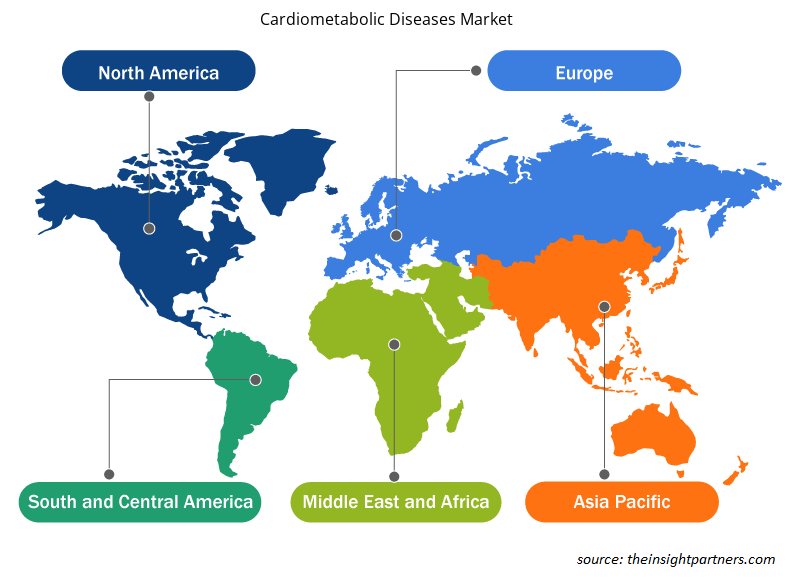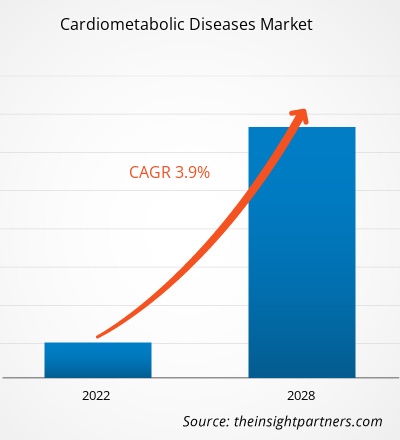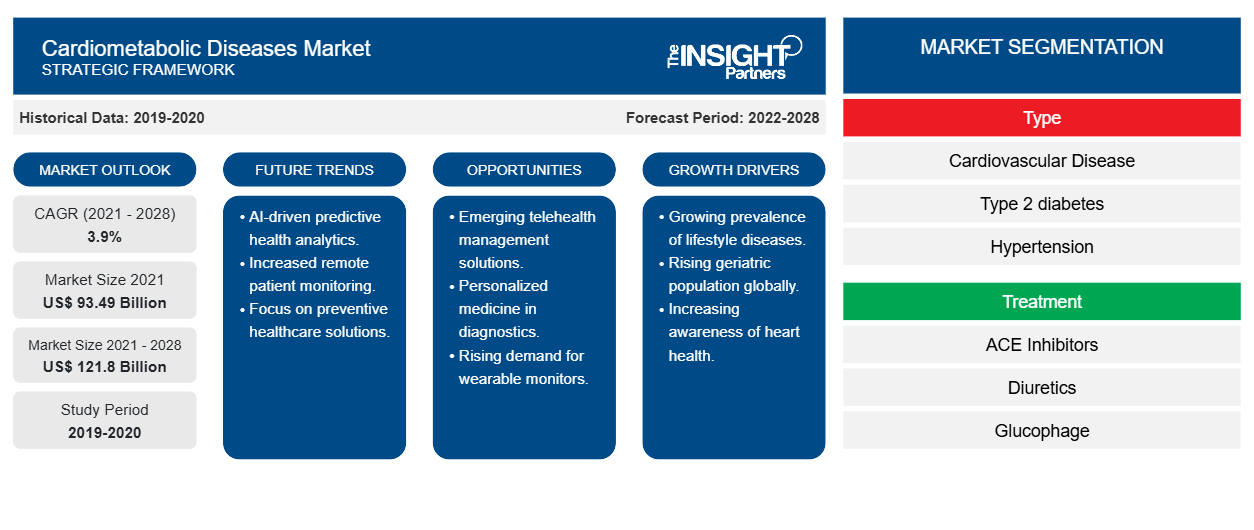Der Markt für kardiometabolische Erkrankungen soll von 93.494,41 Millionen US-Dollar im Jahr 2021 auf 121.804,49 Millionen US-Dollar im Jahr 2028 anwachsen; für den Zeitraum 2021–2028 wird mit einer durchschnittlichen jährlichen Wachstumsrate von 3,9 % gerechnet.
Kardiometabolische Erkrankungen sind durch eine Reihe von Anomalien und Symptomen gekennzeichnet, die das Risiko für die Entwicklung von Herz-Kreislauf-Erkrankungen erhöhen. Bluthochdruck, Fettleibigkeit, Insulinresistenz, Dyslipidämie, schlechtes Cholesterinprofil (LDL) und Glukosetoleranz sind einige Symptome kardiometabolischer Erkrankungen. Personen, die am kardiometabolischen Syndrom leiden, sind anfällig für viele andere lebensbedrohliche Krankheiten wie Typ-2-Diabetes, Schlaganfall, Koronare Herzkrankheit (KHK) und Herz-Kreislauf-Erkrankungen (CVD). Sowohl genetische als auch Umweltbedingungen sind für die Entwicklung der Krankheiten verantwortlich.
Das Marktwachstum bei kardiometabolischen Erkrankungen ist hauptsächlich auf Faktoren wie die zunehmende Verbreitung kardiometabolischer Erkrankungen und Innovationen bei der Behandlung von CMD zurückzuführen. Die Unterdiagnose von CVDs in Ländern mit niedrigem und mittlerem Einkommen (LMICs) behindert jedoch das Wachstum des Marktes.
Passen Sie diesen Bericht Ihren Anforderungen an
Sie erhalten kostenlose Anpassungen an jedem Bericht, einschließlich Teilen dieses Berichts oder einer Analyse auf Länderebene, eines Excel-Datenpakets sowie tolle Angebote und Rabatte für Start-ups und Universitäten.
-
Holen Sie sich die wichtigsten Markttrends aus diesem Bericht.Dieses KOSTENLOSE Beispiel umfasst eine Datenanalyse von Markttrends bis hin zu Schätzungen und Prognosen.
Markteinblicke
Zunehmende Prävalenz kardiometabolischer Erkrankungen
Kardiometabolische Erkrankungen (CMDs) sind eine der häufigsten Todesursachen weltweit. Diese Erkrankungen werden hauptsächlich durch einen ungesunden Lebensstil, körperliche Inaktivität, Rauchen und eine ungesunde Ernährung verursacht. Zu den CMDs zählen Herz-Kreislauf-Erkrankungen (CVDs), Diabetes mellitus und chronisches Nierenversagen. Laut WHO starben im Jahr 2019 rund 17,9 Millionen Menschen an CVDs, was 32 % aller Todesfälle weltweit entspricht. Von diesen Todesfällen waren 85 % auf Herzinfarkt und Schlaganfall zurückzuführen.
Die meisten Herz-Kreislauf-Erkrankungen können durch die Bekämpfung verhaltensbedingter Risikofaktoren wie Tabakkonsum, ungesunde Ernährung, Fettleibigkeit, Bewegungsmangel und Alkoholkonsum verhindert werden. Diabetes ist eine der lebensbedrohlichen chronischen Krankheiten, für die es keine funktionelle Heilung gibt. Sie führt zu verschiedenen Komplikationen und erhöht das allgemeine Risiko eines vorzeitigen Todes. Herzinfarkt, Schlaganfall, Nierenversagen, Beinamputation, Sehverlust und Nervenschäden sind die wichtigsten mit Diabetes verbundenen Komplikationen. Laut der International Diabetes Federation (IDF) lebten im Jahr 2019 etwa 463 Millionen Erwachsene mit Diabetes, und bis 2045 werden voraussichtlich 700 Millionen davon betroffen sein.
Aufgrund zunehmenden Rauchens, Bewegungsmangels, Alkoholkonsums und ungesunder Ernährungsgewohnheiten steigt weltweit die Zahl der Menschen mit einer oder mehreren CMDs. Laut WHO-Statistiken vom Juli 2021 sterben jedes Jahr mehr als 8 Millionen Menschen an den Folgen des Tabakkonsums. Der Tabakkonsum ist in Ländern mit niedrigem und mittlerem Einkommen höher, 80 % der weltweiten Verbraucher leben in diesen Ländern. Die zunehmende Verbreitung von Fettleibigkeit führt dazu, dass auch immer mehr Patienten an CMDs leiden. Mit diesem rasanten Anstieg der CMD-Prävalenz ist der Bedarf an geeigneten Behandlungen für kardiometabolische Erkrankungen sprunghaft gestiegen, was zu einem enormen Marktwachstum geführt hat.
Typbasierte Erkenntnisse
Der Markt für kardiometabolische Erkrankungen ist nach Typ in Herz-Kreislauf-Erkrankungen (CVD), Bluthochdruck, Typ-2-Diabetes und Fettleibigkeit unterteilt. Das Segment Herz-Kreislauf-Erkrankungen (CVD) hatte 2021 den größten Marktanteil und wird im Prognosezeitraum voraussichtlich die höchste CAGR auf dem Markt verzeichnen.
Behandlungsbasierte Erkenntnisse
Nach Behandlung ist der Markt für kardiometabolische Erkrankungen in ACE-Hemmer, Diuretika, Glucophage und andere unterteilt. Das Segment der ACE-Hemmer hatte 2021 den größten Marktanteil und es wird erwartet, dass dasselbe Segment im Prognosezeitraum die höchste durchschnittliche jährliche Wachstumsrate (CAGR) auf dem Markt verzeichnet.
Dosierungsbasierte Erkenntnisse
Der Markt für kardiometabolische Erkrankungen ist nach Dosierung in Tabletten und Injektionen unterteilt. Das Tablettensegment hatte 2021 einen größeren Marktanteil und wird im Prognosezeitraum voraussichtlich eine höhere CAGR auf dem Markt verzeichnen.
Einblicke auf der Grundlage der Verabreichungsroute
Der Markt für kardiometabolische Erkrankungen ist nach Verabreichungsart in oral und intravenös unterteilt. Im Jahr 2021 hielt das orale Segment einen größeren Marktanteil und wird in den kommenden Jahren voraussichtlich eine höhere CAGR verzeichnen.
Endbenutzerbasierte Erkenntnisse
Der Markt für kardiometabolische Erkrankungen ist nach Endverbrauchern in Kliniken, Krankenhäuser und häusliche Pflege unterteilt. Im Jahr 2021 hielt das Krankenhaussegment den größten Marktanteil und wird im Prognosezeitraum voraussichtlich die höchste durchschnittliche jährliche Wachstumsrate (CAGR) auf dem Markt verzeichnen.
Produkteinführungen und Zulassungen sind häufig von Unternehmen angewandte Strategien, um ihre globale Präsenz und ihr Produktportfolio zu erweitern. Darüber hinaus konzentrieren sich die Marktteilnehmer für im Labor entwickelte Tests auf die Partnerschaftsstrategie, um ihren Kundenstamm zu vergrößern, was ihnen wiederum ermöglicht, ihren Markennamen weltweit aufrechtzuerhalten.
Der Bericht segmentiert den Markt für kardiometabolische Erkrankungen wie folgt
Basierend auf der Art ist der Markt für kardiometabolische Erkrankungen in Herz-Kreislauf-Erkrankungen (CVD), Bluthochdruck, Typ-2-Diabetes und Fettleibigkeit unterteilt. Basierend auf der Behandlung ist der Markt in ACE-Hemmer, Diuretika, Glucophage und andere unterteilt. Basierend auf der Dosierung ist der Markt für kardiometabolische Erkrankungen in Tabletten und Injektionen unterteilt. Basierend auf der Verabreichungsmethode ist der Markt in oral und intravenös unterteilt. Basierend auf den Endverbrauchern ist der Markt für kardiometabolische Erkrankungen in Kliniken, Krankenhäuser und häusliche Pflege unterteilt. Geografisch ist der Markt in Nordamerika (USA, Kanada und Mexiko), Europa (Großbritannien, Deutschland, Frankreich, Italien, Spanien und übriges Europa), Asien-Pazifik (China, Japan, Indien, Australien, Südkorea und übriger Asien-Pazifik), Naher Osten und Afrika (VAE, Saudi-Arabien, Südafrika und übriger Naher Osten und Afrika) und Süd- und Mittelamerika (Brasilien, Argentinien und übriges Süd- und Mittelamerika) unterteilt.
Regionale Einblicke in den Markt für kardiometabolische Erkrankungen
Die regionalen Trends und Faktoren, die den Markt für kardiometabolische Erkrankungen im Prognosezeitraum beeinflussen, wurden von den Analysten von Insight Partners ausführlich erläutert. In diesem Abschnitt werden auch die Marktsegmente und die Geografie für kardiometabolische Erkrankungen in Nordamerika, Europa, im asiatisch-pazifischen Raum, im Nahen Osten und Afrika sowie in Süd- und Mittelamerika erörtert.

- Erhalten Sie regionale Daten zum Markt für kardiometabolische Erkrankungen
Umfang des Marktberichts über kardiometabolische Erkrankungen
| Berichtsattribut | Details |
|---|---|
| Marktgröße im Jahr 2021 | 93,49 Milliarden US-Dollar |
| Marktgröße bis 2028 | 121,8 Milliarden US-Dollar |
| Globale CAGR (2021 - 2028) | 3,9 % |
| Historische Daten | 2019-2020 |
| Prognosezeitraum | 2022–2028 |
| Abgedeckte Segmente |
Nach Typ
|
| Abgedeckte Regionen und Länder |
Nordamerika
|
| Marktführer und wichtige Unternehmensprofile |
|
Marktteilnehmerdichte: Der Einfluss auf die Geschäftsdynamik
Der Markt für kardiometabolische Erkrankungen wächst rasant, angetrieben durch die steigende Nachfrage der Endnutzer aufgrund von Faktoren wie sich entwickelnden Verbraucherpräferenzen, technologischen Fortschritten und einem größeren Bewusstsein für die Vorteile des Produkts. Mit steigender Nachfrage erweitern Unternehmen ihr Angebot, entwickeln Innovationen, um die Bedürfnisse der Verbraucher zu erfüllen, und nutzen neue Trends, was das Marktwachstum weiter ankurbelt.
Die Marktteilnehmerdichte bezieht sich auf die Verteilung der Firmen oder Unternehmen, die in einem bestimmten Markt oder einer bestimmten Branche tätig sind. Sie gibt an, wie viele Wettbewerber (Marktteilnehmer) in einem bestimmten Marktraum im Verhältnis zu seiner Größe oder seinem gesamten Marktwert präsent sind.
Die wichtigsten auf dem Markt für kardiometabolische Erkrankungen tätigen Unternehmen sind:
- Eli Lilly und Company
- Bayer AG
- Arrowhead Pharmaceuticals, Inc
- Novartis AG
- Boehringer Ingelheim International GmbH
Haftungsausschluss : Die oben aufgeführten Unternehmen sind nicht in einer bestimmten Reihenfolge aufgeführt.

- Überblick über die wichtigsten Akteure auf dem Markt für kardiometabolische Erkrankungen
Firmenprofile
- Eli Lilly und Company
- Bayer AG
- Arrowhead Pharmaceuticals, Inc
- Novartis AG
- Boehringer Ingelheim International GmbH
- Novo Nordisk A/S
- AstraZeneca
- Alnylam Pharmaceuticals, Inc.
- Cardax, Inc
- Kowa Company, Ltd.
- Historische Analyse (2 Jahre), Basisjahr, Prognose (7 Jahre) mit CAGR
- PEST- und SWOT-Analyse
- Marktgröße Wert/Volumen – Global, Regional, Land
- Branchen- und Wettbewerbslandschaft
- Excel-Datensatz
Aktuelle Berichte
Erfahrungsberichte
Grund zum Kauf
- Fundierte Entscheidungsfindung
- Marktdynamik verstehen
- Wettbewerbsanalyse
- Kundeneinblicke
- Marktprognosen
- Risikominimierung
- Strategische Planung
- Investitionsbegründung
- Identifizierung neuer Märkte
- Verbesserung von Marketingstrategien
- Steigerung der Betriebseffizienz
- Anpassung an regulatorische Trends























 Kostenlose Probe anfordern für - Markt für kardiometabolische Erkrankungen
Kostenlose Probe anfordern für - Markt für kardiometabolische Erkrankungen